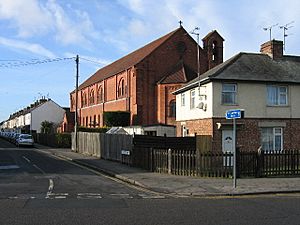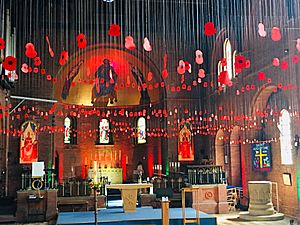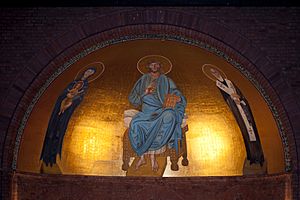St Augustine's Church, Even Swindon facts for kids
The Church of St. Augustine is a special Anglican church in Swindon, England. It is located in an area called Even Swindon, also known as Rodbourne. This church was built in 1907. It was created to help people who moved to Swindon for jobs at the Great Western Railway Works. The church is named after St. Augustine of Canterbury.
Contents
How the Church Started
Before the main church building, there was a smaller place of worship. This was a mission chapel that opened in the early 1880s. It was part of the St Mary Rodbourne Cheney parish. Records show that church services began there on April 2, 1881. The first known baptism happened in 1885.
The Rev W Mould, who was the vicar of St Mary's, found it hard to lead services at the chapel. So, another church, St Mark's Church, helped out. St Mark's was also a "railway" church, built for railway workers.
In 1904, Rev Henry Harvey became the missionary curate for the St Augustine's area. He worked for the church in Rodbourne for 29 years. He was later honored for his long service.
Building and Design
The church building was designed by W. A. H. Masters. He also designed other churches in Swindon.
The first stone for St Augustine's was placed on April 13, 1907. This was a big event. The church was officially ready on January 25, 1908. The people living nearby helped pay for the bricks. Each brick cost one old penny. Because of money limits, some parts like side aisles and a bell tower were not built.
This church is one of the few in southern England built in the basilica style. This means it has a large main hall called a nave. It also has a small rounded area called an apse. There is no wall between the nave and the choir area. This makes it feel like one big hall. The church also has tall, narrow windows called lancet windows. These are in a style called neo-Romanesque. The building became a Grade II listed building in 1970. This means it is an important historic building.
The church is about 37 meters (120 feet) long. It is about 12 meters (40 feet) wide. The roof of the main hall is about 15 meters (50 feet) high. The arch leading to the apse is about 9 meters (30 feet) high. The church has one bell that weighs about 228 kilograms (504 pounds).
Inside the Church
The church has a special font used for baptisms. It is a copy of an old font from St Leonard's Church. The font has ten sections with Latin words and carvings.
- The first section, Eclesia, shows the church. It has a crowned figure holding a cup and fighting a snake.
- The second section, Cherubim, shows a six-winged angel. This angel guards the church.
The other eight sections show knights with shields and weapons. These knights represent good Christian qualities. They are shown defeating figures that represent bad qualities.
- Largitas v Avaricia: Generosity beats Greed.
- Humilitas v Superbia: Humility beats Pride.
- Pietas v Discordia: Gentleness beats Disagreement.
- Misericordia v Invidia: Mercy beats Envy.
- Modestia v Ebrietas: Being sensible beats Drunkenness.
- Temperancia v Luxuria: Self-control beats Wildness.
- Pacientcia v Ira: Patience beats Anger.
- Pucicicia v Libido: Purity beats Impure desires.
Other art in the church includes a painting in the apse. This painting shows Christ Pantocrator (Christ as ruler of all). He is shown with Mary and Child, and an older St Augustine. The painting has a gold background. There are also two icons next to the apse. These show Pope Gregory the Great and King Ethelbert of Kent. Two triptychs (three-part artworks) show the Virgin Mary and Child, and St Augustine holding a model of the church.
The church has six stained glass windows. Three are in the apse. One round window is high in the nave. These are from the church's early years. Two other windows on the south side were added in the 1950s.
Church Community
A special area, or parish, was created for St Augustine's Church in 1930. This area was made from parts of other parishes.
From 2004 to 2018, St Augustine's was part of a group of churches. Since late 2018, St Augustine's has been its own separate parish.
Music at the Church
The church has a strong history of music. In its early days, the choir had almost 50 men and boys. Women joined the choir for the first time in the mid-1970s. The choir once gave a special gift to the choirboys at Westminster Abbey. It was the nameplate of a steam engine called "Westminster Abbey." This nameplate can still be seen there.
Sir John Betjeman, a famous writer, was said to visit the church often for its evening choir services. The choir has sung in many important places. These include St Paul's Cathedral, Westminster Abbey, and St Mary Redcliffe. The choir was well known for its size and quality.
The church has had two organs. The first was a large pipe organ. It was taken out in 2003. Most of its pipes were removed. The current organ is a digital organ. It was given to the church in 2003. Its speakers are high up in the church, about 9 meters (30 feet) above the choir stalls.
Special Events
In 2018, the church had a display of 1,300 poppies. This was to remember the 100th anniversary of the Armistice. This event marked the end of World War One. Students from Even Swindon Primary School and church members made the poppies. They hung on thin lines, making them look like they were floating. Other displays included knitted poppies and information about local men who died in the war. Photos of the display were in many UK newspapers. The church was also used for a live TV broadcast on November 9, 2018.





